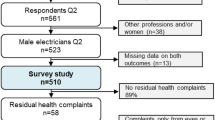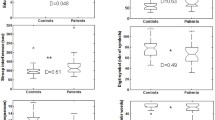Objectives. To assess cognitive impairment in people accidentally exposed to radiation. Materials and methods. The study included individuals living in the Techa river basin, who are included in the “People” database of the Urals Research Center for Radiation Medicine, Federal Medical and Biological Agency of Russia. The study group included 38 people with soft tissue irradiation doses of ≥0.07 Gy and the control group consisted of 38 people selected by the matched pair case-control method who had been exposed to soft tissue doses not exceeding the background level. Clinical methods, assessment of cognitive evoked potentials (EP), clinical psychological methods, and statistical methods were used. Results. The study group showed a tendency towards an increase in the proportion of subjects with mild cognitive impairment (F06.7) and statistically significantly greater proportions of individuals with cognitive impairment syndrome (p = 0.039; OR = 2.9; 95% CI 1.2–7.5), dyssomnia syndrome (p = 0.022; OR = 2.6; 95% CI 1.04–6.6), and complaints of decreased memory for current events (p = 0.034; OR = 2.8; 95% CI 1, 1–7.5). This group showed statistically significant differences as compared with the control group in individual indicators of P300 latency (LP) (p = 0.009); this group also showed a statistically significantly greater proportion of individuals with LP increased by 3 sigma or more (p = 0.025; OR = 6.4, 95% CI 1.3–31.7). Conclusions. Cognitive impairments were more marked in the study group, this being apparent as an increase in the proportion of subjects with mild cognitive impairment (F06.7), cognitive decline syndrome, complaints of deterioration in cognitive functions, and lengthening of P300 LP.
Similar content being viewed by others
References
A. V. Alekssev (ed.), Consequences of Radioactive Contamination of the River Techa, Kniga, Chelyabinsk (2016).
A. V. Akleev and S. A. Shalaginov, “Comparative analysis of the results of the health evaluation of exposed residents in Chelyabinsk Regional Interdepartmental Expert Council over the period from 1990 through 2015,” Radiats. Gigien., 11, No. 1, 6–17 (2018), https://doi.org/10.21514/1998-426X-2018-11-1-6-17.
E. B. Burlakova, D. M. Grodzinsky, K. N. Loganovsky, et al., “Chernobyl and new knowledge about the impact of low doses of radiation,” in: The Chernobyl Disaster, (2016), pp. 63–106.
K. N. Loganovsky, S. V. Masiuk, V. A. Buzunov, et al., “Radiation risk analysis of neuropsychiatric disorders in Ukrainian Chornobyl catastrophe liquidators,” Front. Psychiatry, 11, 1043 (2020), https://doi.org/10.3389/fpsyt.2020.553420.
S. A. Igumnov and P. S. Lapanov, “Early and late psychological disorders in Chernobyl NPP clean-up workers,” Psikhiatr. Psikhoter. Klin. Psikhol., 7, No. 2, 244–257 (2016).
E. G. Koroleva, “The infl uence of the late effects of the Chernobyl NPP accident on mental health of the clean-up workers and their treatment,” Zh. Grodnensk. Gos. Med. Univ., 16, No. 1, 77–83 (2018).
F. F. Tetenev, Ya. V. Porovskii, T. V. Matkovskaya, et al., “30 years after the Chernobyl NPP accident: results of clinical follow up of the clean-up workers,” Sibirsk. Med. Obozr., 115, No. 1, 25–33 (2019).
Ya. V. Porovskii and F. F. Tetenev,, “Infl ammatory factors and status of the microvasculature in patients exposed to low-dose ionizing radiation,” Vestn. Nov. Med. Tekhnol., XIX, No. 2, 358–361 (2012).
V. V. Gnezditskii and O. S. Korepina, Atlas of Brain Evoked Potentials, PresSto, Ivanovo (2011).
V. V. Gnezditskii, O. S. Korepina, and A. V. Chatskaya, Cognitive EP (R300): Basic Methods and Clinical Application, Infomed, Moscow (2017).
D. Karis, M. Fabiani, and E. Donchin, “’P300’ and memory: Individual differences in the von Restorff effect,” Cogn. Psychol., 16, No. 2, 177–216 (1984), https://doi.org/10.1016/0010-0285(84)90007-0.
E. A. Litvinchuk, T. E. Kantina, and E. Yu. Burtovaia, “Results of the study of the cognitive evoked potentials in people exposed to radiation,” Byull. Sibirsk. Med., 18, No. 4, 85–91 (2019).
L. A. Zhavoronkova, A. P. Belostotskii, N. B. Kholodova, et al., “Impairments to higher mental functions and cognitive auditory evoked potentials in Chernobyl clean-up workers,” Neurosci. Behav. Physiol., 43, 887 (2013), https://doi.org/10.1007/s11055-013-9824-y.
K. N. Loganovsky, D. Marazziti, F. Mucci, et al., “Changes of event-related potentials as markers of early brain damage following ionizing radiation. State of the art and future perspectives,” Clin. Neuropsychiatry, 15, No. 6, 353–359 (2018).
K. M. Loganovsky and K. V. Kuts, “Cognitive evoked potentials P300 after radiation exposure,” Probl. Radiac. Med. Radiobiol., 21, 264–290 (2016).
Author information
Authors and Affiliations
Corresponding author
Additional information
Translated from Zhurnal Nevrologii i Psikhiatrii imeni S. S. Korsakova, Vol. 122, No. 7, pp. 132–137, July, 2022.
Rights and permissions
Springer Nature or its licensor (e.g. a society or other partner) holds exclusive rights to this article under a publishing agreement with the author(s) or other rightsholder(s); author self-archiving of the accepted manuscript version of this article is solely governed by the terms of such publishing agreement and applicable law.
About this article
Cite this article
Litvinchuk, E.A., Kantina, T.E. & Burtovaia, E.Y. Assessment of Cognitive Functions in Patients Accidentally Exposed to Radiation. Neurosci Behav Physi 53, 319–323 (2023). https://doi.org/10.1007/s11055-023-01428-2
Received:
Accepted:
Published:
Issue Date:
DOI: https://doi.org/10.1007/s11055-023-01428-2




